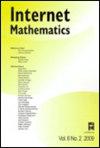Introduction to the Special Issue on Biological Networks
Q3 Mathematics
引用次数: 2
Abstract
In this special issue on biological networks, we aim to interest the readership of Internet Mathematics in network theory applied to bioinformatics. Network biology is a new and emerging research area that is fast-growing, spurred by the collection of biological data representing connections or interactions of molecules in the cell. As such, it has the potential to have at least as profound an impact on our understanding of the cell as sequence data has had. However, the datasets are large, noisy and many graph theoretic problems are formally intractable (impossible to solve exactly in any time less than the age of the universe), and so heuristic approximations must be developed in an attempt to find approximate solutions. Furthermore, the tools developed to solve these problems must be made accessible to biological practitioners. In this direction, this issue contains papers on the many databases available, theoretical and algorithmic advances in analyzing these data, as well as papers on some specific biomedical applications, and two papers introducing software tools. This issue presents six papers from some of the leading research groups in the area. Three papers present significant theoretical advances in techniques. Two of them (Elberfeld et al.; Crofts and Higham) look at directed graphs. First, Elberfeld et al. attack the “maximum graph orientation problem”, in which, given a list of source-sink pairs of nodes, we attempt to add direction to an undirected graph in such a way as to maximize the number of pairs for which directed paths exist from the source to the sink. This has applications in the problem of learning biological pathways, but Elberfeld et al. show that the problem is NP-hard生物网络特刊导论
在这期关于生物网络的特刊中,我们的目标是让互联网数学的读者对网络理论在生物信息学中的应用感兴趣。网络生物学是一个快速发展的新兴研究领域,受到细胞中分子连接或相互作用的生物学数据收集的刺激。因此,它有可能对我们对细胞的理解产生至少与序列数据一样深远的影响。然而,数据集很大,有噪声,许多图论问题在形式上是难以解决的(不可能在小于宇宙年龄的任何时间内精确解决),因此必须开发启发式近似来试图找到近似解。此外,为解决这些问题而开发的工具必须使生物学从业者能够使用。在这个方向上,这一期包含了关于许多可用数据库的论文,分析这些数据的理论和算法进展,以及关于一些特定生物医学应用的论文,以及两篇介绍软件工具的论文。本期杂志介绍了该领域一些主要研究小组的六篇论文。三篇论文介绍了技术方面的重大理论进展。其中两人(Elberfeld et al.;Crofts和Higham)研究有向图。首先,Elberfeld等人解决了“最大图方向问题”,在该问题中,给定一个源-汇节点对列表,我们试图以这样一种方式为无向图添加方向,从而使从源到汇存在有向路径的对的数量最大化。这在学习生物途径的问题上也有应用,但Elberfeld等人表明这个问题是np困难的
本文章由计算机程序翻译,如有差异,请以英文原文为准。
求助全文
约1分钟内获得全文
求助全文

 求助内容:
求助内容: 应助结果提醒方式:
应助结果提醒方式:


